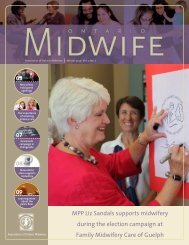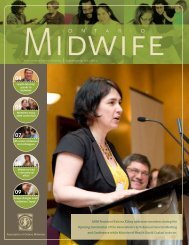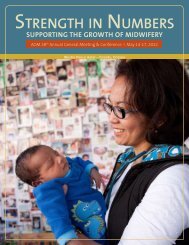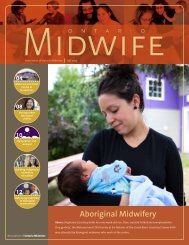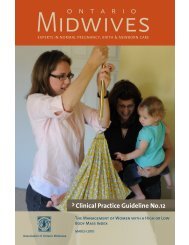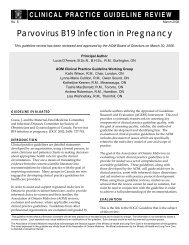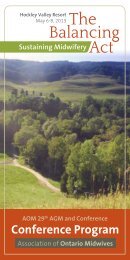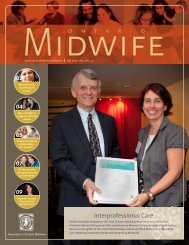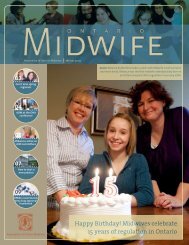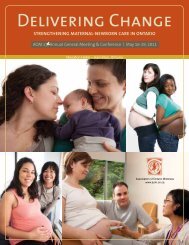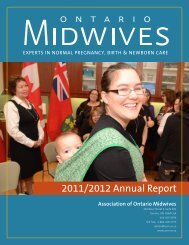Association of Ontario Midwives Summer 2012
Association of Ontario Midwives Summer 2012
Association of Ontario Midwives Summer 2012
Create successful ePaper yourself
Turn your PDF publications into a flip-book with our unique Google optimized e-Paper software.
AOM Conference and Annual General Meeting<br />
Strength in numbers: supporting the growth <strong>of</strong> midwifery<br />
When Minister <strong>of</strong> Health and Long-Term<br />
Care Deb Matthews stopped by<br />
the Annual General Meeting and<br />
Conference closing ceremonies to<br />
announce funding for a practice in<br />
Attawapiskat, the crowd responded<br />
with a standing ovation. Funding<br />
a practice for a remote Aboriginal<br />
community in great need garnered an<br />
emotional reaction from members.<br />
This continued<br />
support for the<br />
growth <strong>of</strong> midwifery<br />
is key as the<br />
first class <strong>of</strong> the<br />
expanded Midwifery<br />
Education Program<br />
(MEP) graduates<br />
this spring. The<br />
MEP now enrolls 90 Elizabeth Brandeis, RM<br />
new students each<br />
AOM vice-president<br />
year at the three<br />
sites combined,<br />
compared with 60<br />
prior to 2008. There are more than 600<br />
midwives currently practicing in <strong>Ontario</strong><br />
and by 2015 it is anticipated there will<br />
be more than 1,000.<br />
This year’s conference theme, Strength<br />
in Numbers, Supporting the Growth<br />
<strong>of</strong> Midwifery, addressed the need<br />
for careful thought about shaping a<br />
growing pr<strong>of</strong>ession and addressing the<br />
challenges inherent to that growth.<br />
Conference presenter and assistant<br />
dean <strong>of</strong> midwifery at McMaster<br />
University Eileen Hutton says the<br />
larger number <strong>of</strong> students has created<br />
a challenge with regard to physical<br />
space for clinical placements.<br />
“When we were starting out, practices<br />
were new, underutilized, there was lots <strong>of</strong><br />
space,” Hutton says. “Now practices have<br />
more midwives but they haven’t changed<br />
space . . . so even if the birth capacity is<br />
there, the space availability isn’t.”<br />
Finding non-midwifery clinical placements<br />
is also proving to be difficult as<br />
other health education programs are<br />
also looking to grow their pr<strong>of</strong>essions.<br />
“We have more students, but the<br />
medical programs have also grown<br />
quite a lot . . . so there is direct competition<br />
for spots,” Hutton says.<br />
Fundamental changes both within<br />
the pr<strong>of</strong>ession and beyond will<br />
have to be explored to help address<br />
the changing needs <strong>of</strong> a growing<br />
pr<strong>of</strong>ession, Hutton says.<br />
“Having our own standards allow us to<br />
advocate on behalf <strong>of</strong> our clients who<br />
may choose care that may not be reflected<br />
in other pr<strong>of</strong>essional guidelines yet is<br />
evidence-based, reasonable and safe.”<br />
Universities may need to work with<br />
hospitals to change how placements<br />
work; Hutton suggested a “package<br />
deal” where hospitals who want<br />
medical residents<br />
also get midwifery<br />
students, nursing<br />
students and<br />
physiotherapy<br />
students, among<br />
others.<br />
As the pr<strong>of</strong>ession<br />
grows, some<br />
hospitals are<br />
capping the<br />
number <strong>of</strong><br />
midwives<br />
practicing there.<br />
Hospitals and<br />
health care providers need to work<br />
together to find solutions to support<br />
the growth <strong>of</strong> midwifery. For example,<br />
having OBs on salary would enable<br />
midwives to attend increasing<br />
numbers <strong>of</strong> low-risk births, Hutton<br />
suggested.<br />
<strong>Association</strong> <strong>of</strong> <strong>Ontario</strong> <strong>Midwives</strong><br />
vice-president Elizabeth Brandeis’s<br />
conference panel presentation focused<br />
on how a greater understanding is<br />
needed <strong>of</strong> both the similarities and<br />
differences between the midwifery<br />
model and care provided by obstetricians<br />
and other providers.<br />
“It’s important to establish where<br />
common ground exists,” she says.<br />
“Working in interpr<strong>of</strong>essional groups<br />
like MoreOB and labour and delivery<br />
committees allows midwives to<br />
interact on a more personal level<br />
with leaders in the hospital and<br />
set the tone for understanding the<br />
foundation on which differences may<br />
exist and when common standards<br />
are appropriate.”<br />
She noted that advocating for midwifery<br />
community standards is an essential<br />
part <strong>of</strong> growing a strong pr<strong>of</strong>ession.<br />
“If we don’t have our own midwifery<br />
community standards, we are forced<br />
to conform to other established<br />
standards,” she says. “Having our own<br />
standards allows us to advocate on<br />
behalf <strong>of</strong> our clients who may choose<br />
care that may not be reflected in other<br />
pr<strong>of</strong>essional guidelines yet is evidencebased,<br />
reasonable and safe.”<br />
Advocating for midwifery standards<br />
in a hospital setting and educating<br />
other pr<strong>of</strong>essionals about midwifery is<br />
critical. Brandeis says midwives should<br />
initiate conversation via planning a<br />
rounds or presenting to a committee.<br />
Using tools such as clinical practice<br />
guidelines (CPG) can depersonalize<br />
conflict and show hospital colleagues<br />
that midwives are part <strong>of</strong> a wellinformed<br />
pr<strong>of</strong>essional community.<br />
“Our clients come to us with the<br />
expectation that their choices will be<br />
respected and supported. CPGs provide<br />
a framework for us to inform and<br />
support our clients in a range <strong>of</strong> diverse<br />
choices,” she says. “When the conversation<br />
is about the client and supporting<br />
her autonomy and choice, the issues can<br />
move away from ‘us vs. them’ and focus<br />
on client-centred, evidence-based care<br />
that supports normal birth.”<br />
Providing support toward the kind <strong>of</strong><br />
research that informs tools such as the<br />
CPGs is an important next step in moving<br />
midwifery forward, Hutton says. Though<br />
other pr<strong>of</strong>essions can tap into dedicated<br />
pockets <strong>of</strong> funding, such as hospital<br />
competitions, midwives have few<br />
funding streams to support research.<br />
“In the last 20 years we’ve focused<br />
on building a very strong education<br />
program and strong practices . . . and<br />
we are getting to a size where we can<br />
put money into (research),” Hutton<br />
says. “Practice didn’t evolve without<br />
lots <strong>of</strong> support, and I think research is<br />
no different.”<br />
One <strong>of</strong> the benefits <strong>of</strong> expanding<br />
the MEP and growing the number<br />
<strong>of</strong> midwives is that strength really<br />
does come in numbers. Now more<br />
than ever, midwives can capitalize<br />
on opportunities for creating new<br />
practices, improving hospital<br />
relations, and advocating for<br />
dedicated research funds.<br />
6<br />
ontario midwife • <strong>Summer</strong> <strong>2012</strong>




